Federal food aid in Wisconsin has evolved, but users still face decades-old barriers
The former head of Wisconsin's FoodShare program says qualifying for and maintaining food assistance is overly cumbersome for participants.
Wisconsin Watch
August 8, 2022
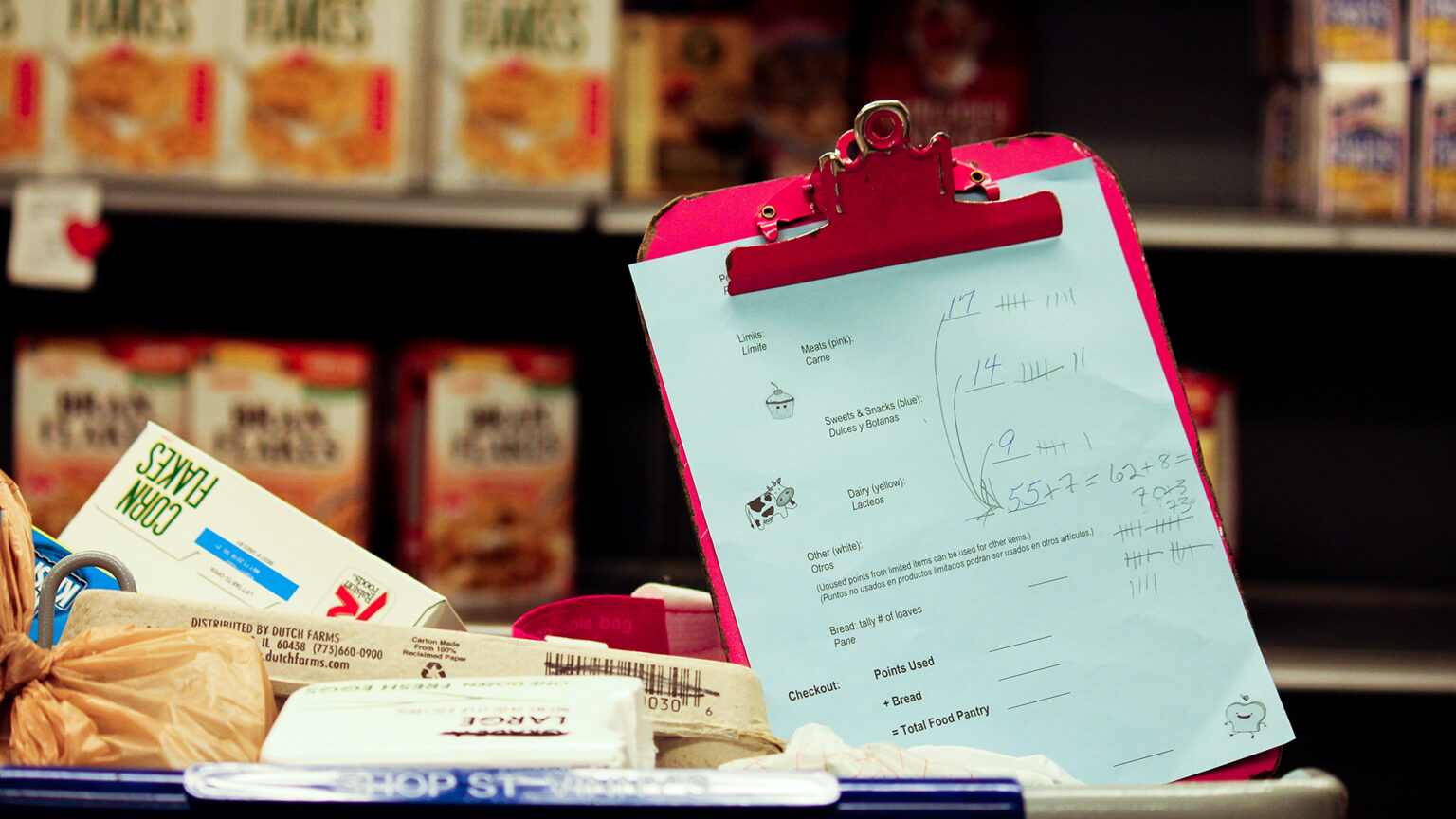
A food group checklist is seen in the shopping cart of a patron at the St. Vincent de Paul Society food pantry in Madison. An employee from St. Vincent's helps people make selections, to make sure they are meeting the limits of each food group they are allowed to take. Most shoppers at the food pantry are eligible for FoodShare benefits, according to spokeswoman Lauren Cnare. Photo taken Aug. 31, 2017. (Credit: Kruti Yellapantula / Wisconsin Watch)

By Joey Prestley and Sam Watson, Wisconsin Watch
Although she’s been receiving federal food assistance for around 15 years, Madison resident Elizabeth Blume has never eaten government cheese. She’s heard horror stories from people who have, though.
“There was just this big block of (…) something gelatinous that was orange,” Blume said.
Today, federal food programs no longer rely on surplus dairy products to feed food-insecure Americans. Eligibility requirements have been loosened, there are easier payment options, and the current system provides users with more choice and dignity.
While Blume, 39, has more choice than early commodity recipients, it’s still hard to maintain a balanced diet using food pantry donations and FoodShare benefits.
“Healthy food should be a basic right for everyone, but it’s just not,” Blume said.
Before the pandemic, the $155 per month she received in FoodShare benefits made it hard to buy food that matched her dietary needs. For example, she’s lactose intolerant — but she couldn’t always afford $5 gallons of lactose-free milk.
Instead, Blume often sticks to cheap foods like rice and potatoes. Her meals vary depending on the time of the month and how much FoodShare money she has left; during her more difficult weeks, she eats only cereal and depends on food pantries for donations. She feels the consequences physically.
“You just feel more tired,” Blume said. “You feel sluggish. Your digestion is not quite … on par. (But) you don’t have a choice.”
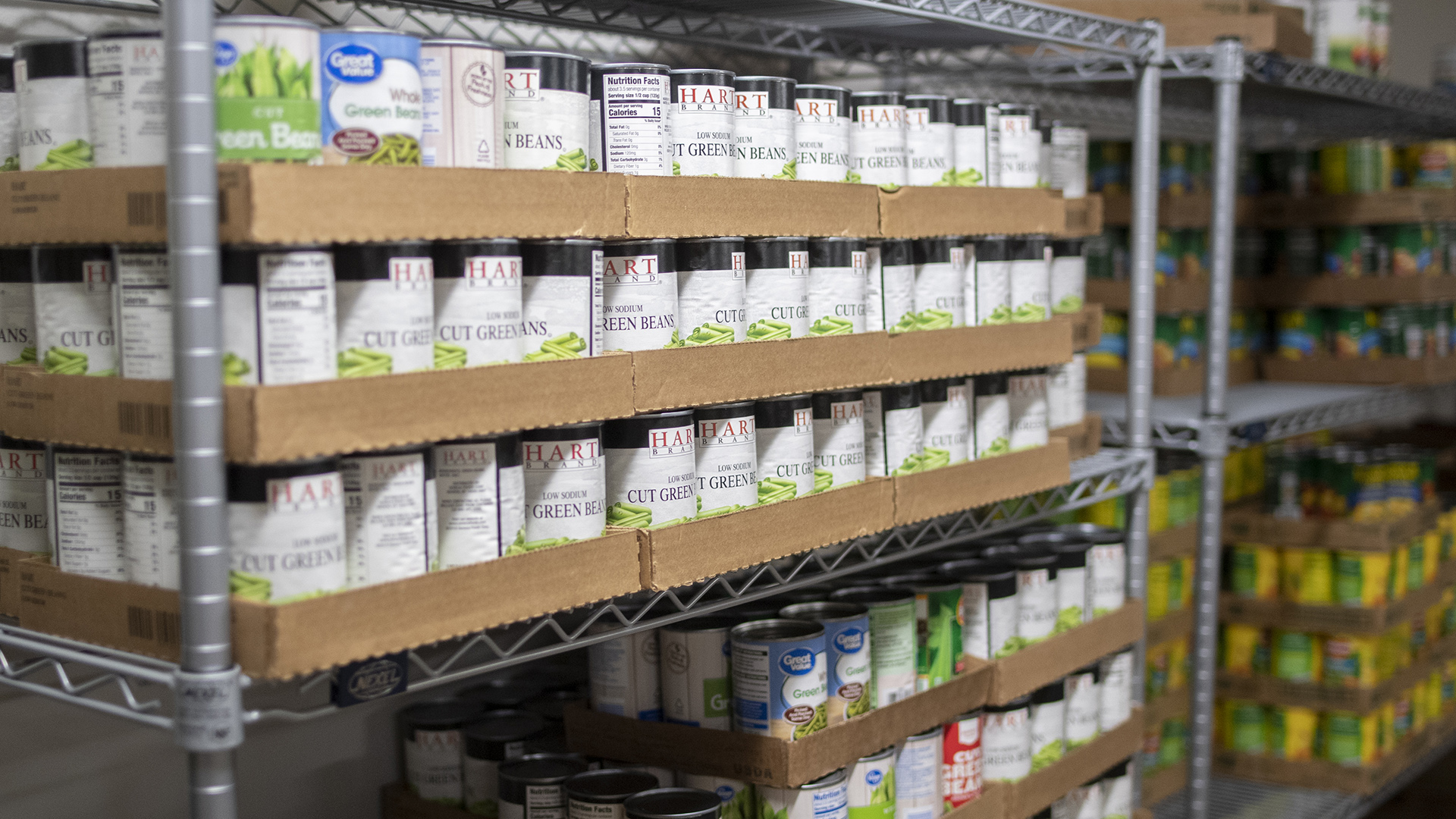
In addition to government-funded food assistance, many low-income Americans use charitable food pantries, such as the Salvation Army Distribution Center food pantry on 60th Street in Milwaukee. Photo taken July 13, 2021. (Credit: Isaac Wasserman / Wisconsin Watch)
Insufficient benefits aren’t the only hurdle. Participants must navigate a convoluted process to apply for and keep food assistance. And they continue to face social stigma for participating in a program that’s been around in one form or another for nearly 90 years.
A top official formerly in charge of administering Wisconsin’s Supplemental Nutrition Assistance Program, known as FoodShare, says the process is hopelessly complex for the people it seeks to help.
“I’m a well-educated, smart individual, (and) that was my job, and if I had to apply for benefits, I would be challenged to do so,” said Rebecca McAtee, who ran the program in the Department of Health Services from 2016 to 2021.
Benefits vary nationwide
Across the country, there is little consistency as to who can receive benefits and how. Each state differs in how it counts assets, if it requires work and how often recipients must report their income to renew benefits.
Wisconsin’s program requires able-bodied recipients between the ages of 18 and 49 to work, do job training or complete job search activities for at least 80 hours per month. Exemptions apply for recipients who have a child in the household and for primary caregivers of people who cannot care for themselves.
Since the pandemic, all work requirements have been waived, but Hunger Task Force Executive Director Sherrie Tussler said they will likely be reinstated by fall. The work requirement waiver expires on Sept. 30, but it may be extended past that date.

Sherrie Tussler, executive director of the Hunger Task Force based in Milwaukee, says she expects the state Legislature will try to reinstate work requirements for Wisconsin’s FoodShare program, which were suspended during the pandemic. (Credit: Courtesy of Hunger Task Force)
In Wisconsin, recipients cannot make more than 200% of the poverty level or risk losing FoodShare. A single recipient cannot earn more than $2,148 per month, or $25,776 a year, to qualify for help. A family of four cannot make more than $53,016 a year.
In the past two decades, the percentage of Wisconsinites using FoodShare has more than doubled. In 2001, 6.8% of the state’s residents received FoodShare benefits. In 2020, it was 15.7%. The program had a recent high participation of 19.1% in 2013.
And government funding for Wisconsin’s FoodShare program in 2021 stood at $2.1 billion — by far the highest it’s been in a decade. That has sparked concerns from legislative Republicans that the state is spending too much and possibly disincentivizing work.
Frustration sparks food stamps program
The federal food assistance program has changed in numerous ways since it was implemented in 1933. During the Great Depression, America faced twin crises: starvation and surplus. While impoverished families went hungry, crop prices declined and farmers were left with excess food. In response, the federal government bought up surplus foods and distributed them to people in need.
But the food, consisting of whatever farmers and manufacturers produced too much of, provided little nutritional balance. Families waited in line to receive huge quantities of commodity foods, from canned goods to perishables including cheese and potatoes. They ate the same foods for a month before the next box arrived.
Since federal food assistance programs were first implemented, users like Blume have expressed dissatisfaction with them. Frustration from commodity recipients, combined with lobbying from the food industry, led to the creation of the first food stamps program in 1939.

This was the first printing of food stamps at the Bureau of Engraving and Printing in Washington, D.C., in April 1939. The stamps were issued to low-income Americans, allowing them to cash each $1 stamp for food worth $1.50. Imogene Stanhope, printer’s assistant at the bureau, is pictured pulling the first batch off the press. (Credit: Harris & Ewing / Library of Congress)
In the early days of the program, families would spend their monthly grocery budget to purchase food stamps. A $10 food stamp purchase would buy the family $10 in orange stamps, which could be used to buy any food. It would also give them $5 in blue stamps, which could only be used to buy government-designated surplus foods.
It also subjected users to social stigma.
“People used to get paper food stamps, and they would go to the grocery store and they were segregated in lines separately from people who were paying with cash or check,” Tussler, the Hunger Task Force director, recalled.
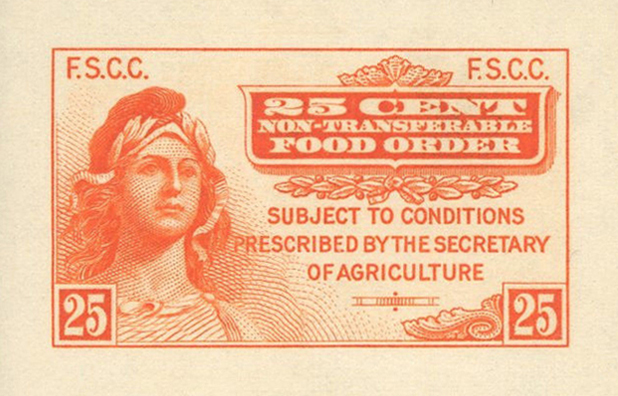
This 1939 orange food stamp could be used to purchase any grocery item while blue stamps could only be used to purchase foods the government marked as surplus.
(Credit: U.S. Department of Agriculture)
The system would publicly label people as poor in an era when poverty was associated with moral shortcomings. Decades later, the humiliation associated with poverty is still present, but it manifests itself more subtly.
‘Doing the right thing’
Britnie Remer used to be angry at her single father for not “doing the right things” to escape poverty. He worked multiple strenuous jobs to provide for her on his own — but the family still needed FoodShare to make ends meet.
Growing up in Elkhorn, Wisconsin, Remer thought that if her father just worked harder, they wouldn’t have to be poor. She told herself, “I’m going to make different choices, and (…) my life will be different and I won’t struggle.”
But in college, Remer realized it wasn’t that simple, falling into $40,000 of student loan debt while she worked two full-time jobs to stay afloat. Later, after years without benefits — and still no degree — she signed up for FoodShare again.

Britnie Remer says food insecurity is a symptom of a system that fabricates scarcity and “prioritizes profit over human life.” Remer, who has relied on FoodShare as a child and as an adult, is a chair for Wisconsin Poor People’s Campaign. She is seen at Oak Park in Wausau, Wis., on July 7, 2022. (Credit: Joey Prestley / Wisconsin Watch)
Today, Remer, who now lives in Wausau, is a chair for Wisconsin Poor People’s Campaign, a community organization that fights systemic poverty. She realized it wasn’t her father’s fault for needing food assistance, nor was it hers. Instead, she said it was a symptom of a system that fabricates scarcity and “prioritizes profit over human life.”
Though Remer understands this, she still suffered the social stigma of poverty. It was obvious at grocery stores, when her father would pay with an Electronic Benefit Transfer (EBT) card, the form of payment used by FoodShare recipients.
“You get people glaring at you when you pull out the green card,” Remer said.
In 2002, the EBT system replaced physical food stamps, allowing recipients to pay for groceries with funds preloaded onto a card. In 2004, Wisconsin renamed the stigma-laden food stamps program FoodShare.
Now, card readers let the cashier know the customer is paying with EBT. Cashiers run EBT payments differently than credit or debit purchases, but in most cases, customers don’t have to say out loud that they are receiving food assistance.
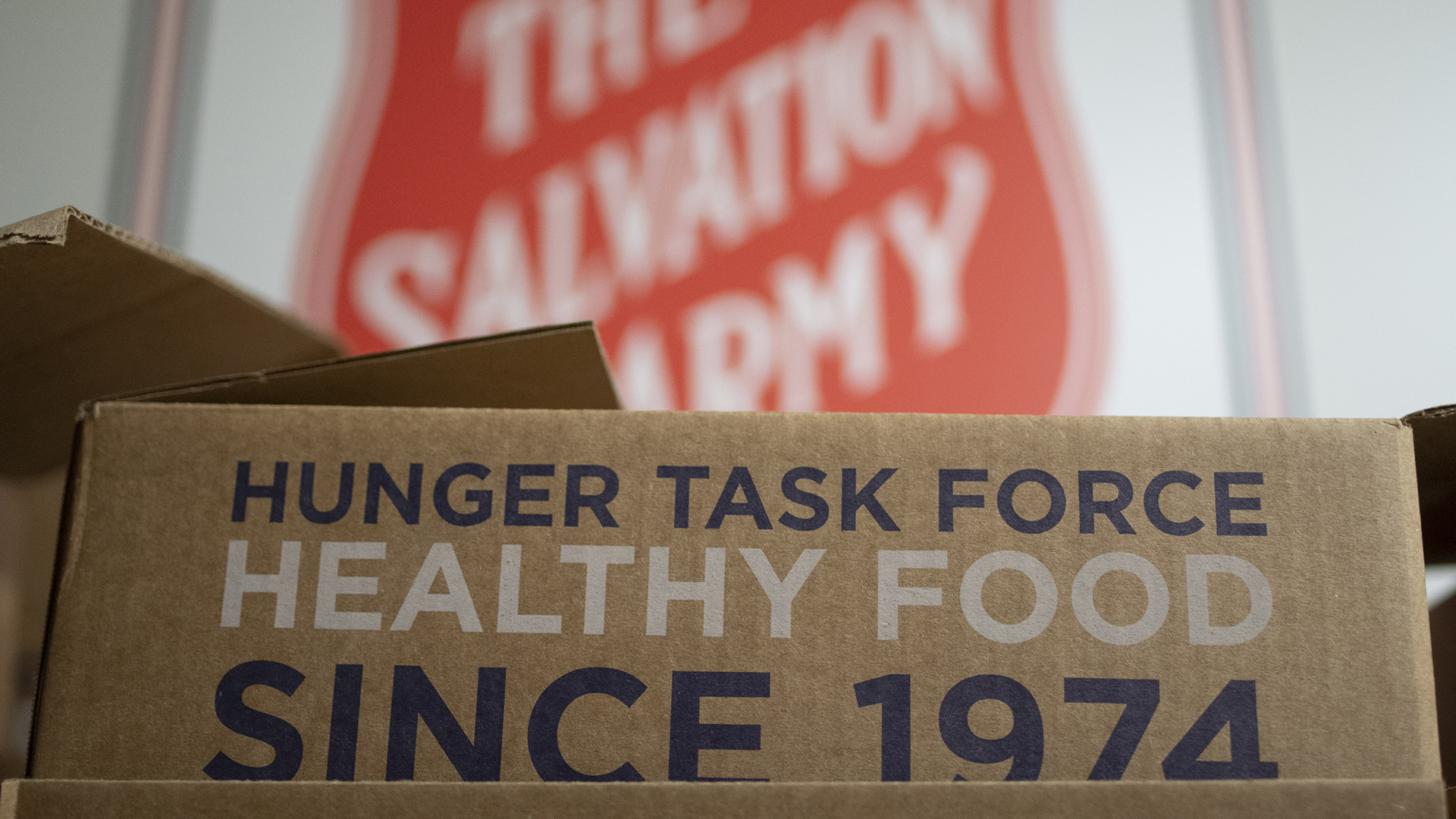
The Hunger Task Force is one of the primary suppliers of food to the Salvation Army’s Milwaukee County pantries. This box of food from the Hunger Task Force as seen in Milwaukee on July 13, 2021 at the Salvation Army’s 60th Street food pantry, one of five Salvation Army food pantries in Milwaukee County. (Credit: Isaac Wasserman / Wisconsin Watch)
Small changes like this help reduce the stigma around food assistance, Blume said.
“It’s not that hard,” Blume said. “It’s not that much to do, just to just take tiny little steps.”
‘So many loopholes’
Still, the path to less stigma and more choice was not straight. In the decades after the first food stamps program lapsed during World War II, legislative efforts to revive it failed to take hold. In 1944, Wisconsin Sen. Robert La Follette Jr. cosponsored a bill to reinstate a food stamps program.
This bill would have provided low-income families with stamps to purchase additional food needed to meet minimum nutritional requirements. But in the post-war era, food insecurity was no longer a legislative priority.
Laurie B. Green, an associate professor of history at the University of Texas at Austin, thinks this is because the federal government didn’t recognize hunger domestically. American legislative efforts at the time focused on solving “world hunger,” ignoring similar issues at home.
“Hunger is a problem everywhere but the United States,” Green said. “The United States is immune.” Because of this misconception, it took until 1959 for Congress to reinstate food stamps legislation.
Twenty-five years after food stamps first began, President Lyndon Johnson made it permanent in 1964 as part of the Democratic president’s War on Poverty. The Food Stamp Act also allowed users to purchase a wide variety of foods, not just surplus products.
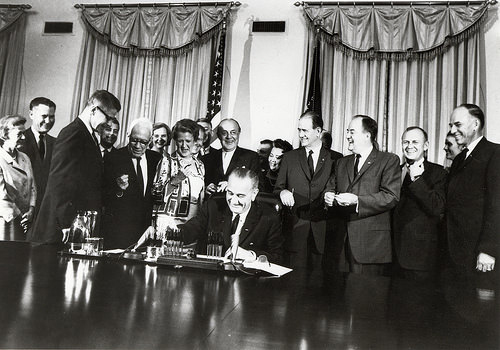
President Lyndon Johnson, a Democrat, signs the Food Stamp Act of 1964, making it a permanent program. Prior to that law, the program was a series of pilots that began in 1961, and not all states participated. Food stamps, which were adopted by all states as of 1974, were considered an improvement over the previous system, which relied heavily on surplus foods, such as meat and cheese, to feed the poor. (Credit: U.S. Department of Agriculture)
But, “there’s so many loopholes in the Food Stamp program,” Green said. “It’s good for some people and it’s a disaster for others.”
The food stamps program was opt-in, meaning states and counties could choose to issue food stamps, continue with the commodity system or not provide any assistance at all. Even when state and local governments implemented the program, Green said individuals with no income or irregular income often could not afford to buy stamps.
As a result, only 18% of America’s poor were served by the food stamp or commodity programs in 1968, according to the influential report, “Hunger, U.S.A.”
Some progress toward greater accessibility was made in 1971, when the Republican administration of President Richard Nixon made food stamps free for those most in need. Three years later, it doubled the average benefits users received and mandated that states implement it.
But the new program had its drawbacks. Some participants had to pay up to 30% of their monthly income upfront in order to receive extra money in stamps. For those living in poverty, the process of getting federal benefits was still too expensive.
In 1979, President Jimmy Carter, a Democrat, remedied this issue by ending the purchase requirement for food stamps. Instead, recipients were given determined amounts of food stamps based on income.

In 1979, President Jimmy Carter, a Democrat, ended the requirement that food stamp recipients had to spend up to 30% of their monthly income to receive extra money in stamps. Instead, recipients were given determined amounts of food stamps based on income. (Credit: Marion Trikosko / Library of Congress)
Despite improvements over the years, nearly 1 out of 5 of those eligible for SNAP do not participate, according to the U.S. Department of Agriculture. That number is lower for the working poor, defined as people who are eligible for SNAP benefits and live in a household where at least one person earns an income. Less than three-fourths of those individuals receive SNAP benefits, according to the USDA.
Searching for solutions
During her time as FoodShare director, McAtee realized the complex and often tedious nature of the application process. It requires extensive paperwork, interviews with a caseworker and notifications whenever a recipient’s monthly income rises above 130% of the poverty level — even if it’s just by a dollar.
Blume is familiar with this issue. One time, she was denied federal food assistance because she surpassed the monthly income limit by $6. Remer, too, has spent years making barely too much money to qualify for FoodShare.
“It’s absolutely sickening, frustrating, heartbreaking,” Blume said.
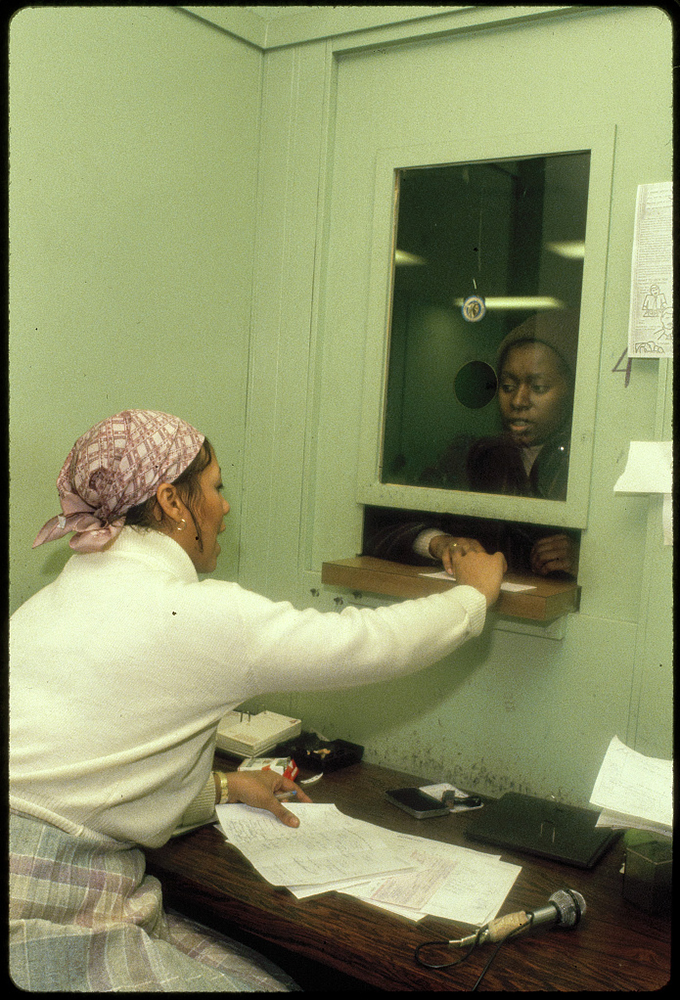
A woman applies for food stamps at an office in New York City in 1981. In 2002, paper stamps were replaced by electronic benefit cards, which aim to reduce stigma and improve privacy for participants. (Credit: Bernard Gotfryd / Library of Congress)
The overly complicated bureaucracy of FoodShare makes it hard for substantial changes to be made, McAtee said. It’s frustrating for all parties involved, she said, adding that was part of the reason she left.
“You can only kind of bang your head against the wall so many times before you’re finally like, ‘This is too much,'” McAtee said.
Chris Kane, director of client services for Society of St. Vincent DePaul Madison, has noticed the government’s inaction in addressing food insecurity.
‘It’s a battle,” Kane said. “We have to fight right now with the system that is in place.”
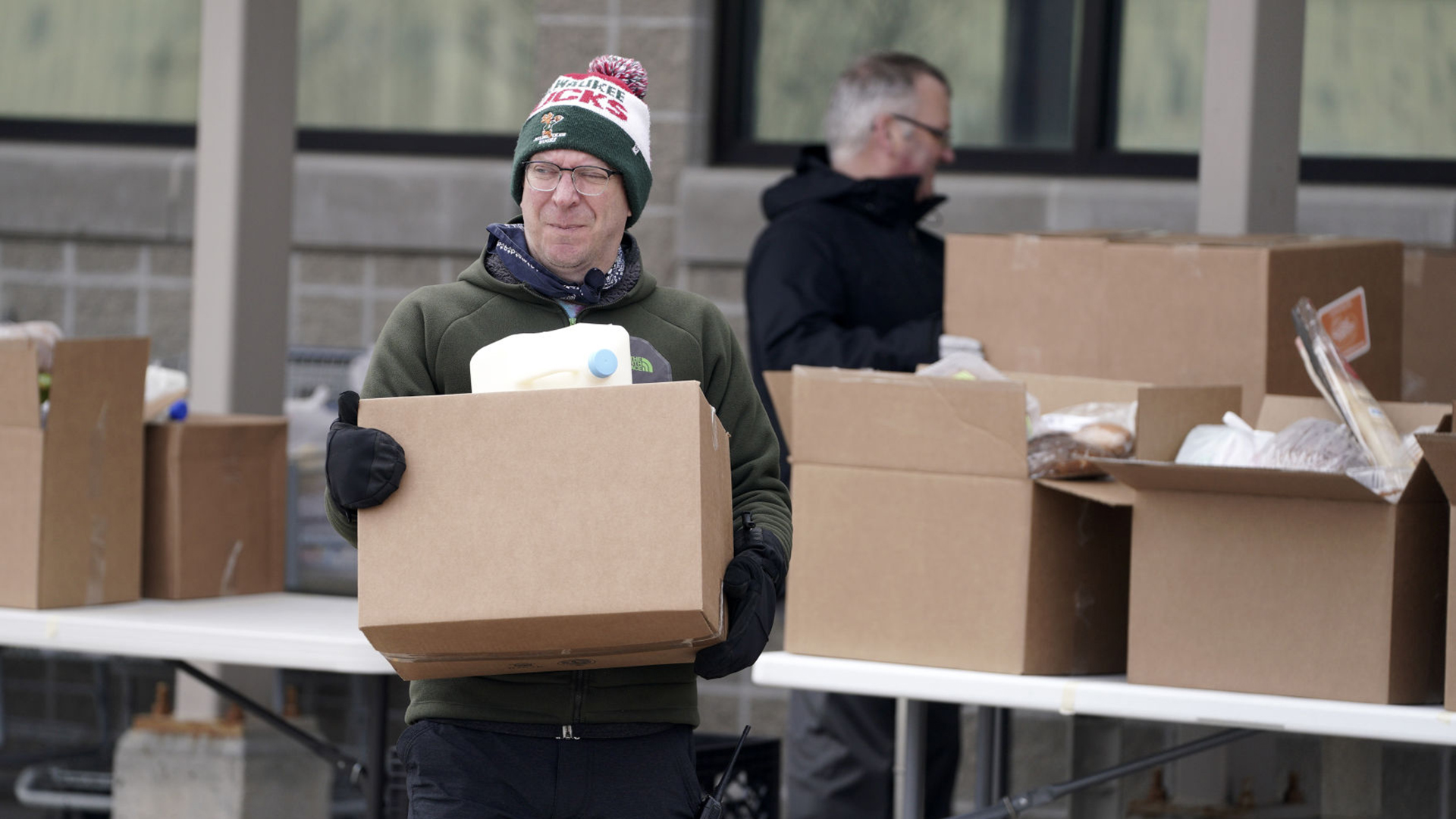
Chris Kane, director of client services at St. Vincent de Paul, helps with curbside delivery at the nonprofit’s food pantry at 2033 Fish Hatchery Road in Madison in March 2020. “I work and run a food pantry,” Kane says. “But I’ve always believed myself that it really is the government that should be taking care of people, and making it so … that people don’t need to go to a place of charity to get food.” (Credit: Steve Apps / Wisconsin State Journal )
Kane has worked for St. Vincent’s food pantry for 26 years. While Kane is happy helping people fight food insecurity, he doesn’t think it should be his job.
“I work and run a food pantry,” Kane said. “But I’ve always believed myself that it really is the government that should be taking care of people, and making it so … that people don’t need to go to a place of charity to get food.’
Pandemic prompts expansion
Just as food stamps began as an emergency response to the Great Depression, the sweeping recent changes to food assistance programs were sparked by another crisis: the COVID-19 pandemic.
The Trump administration had planned to cut back on federal food assistance funding, but in response to the pandemic in 2020, Trump raised all SNAP recipient households to the maximum benefit level based on their income level and family size. Now, a no-income household with two adults and three children could receive $768 per month — around $240 more than before.
Blume had received an extra $95 per month, bumping her FoodShare benefits up to $250 per month total. It has made “a huge difference,” she said.
The Trump administration also instituted the School Pandemic EBT program. This program gave benefits to families whose children could not receive free or reduced lunch due to school closures.
That is why rather than skyrocketing, food insecurity rates remained largely unchanged during the pandemic, said Judi Bartfeld, project coordinator for the Wisconsin Food Security Project at the University of Wisconsin-Madison. She said the “robust” federal response kept people fed, despite widespread unemployment.

Rather than skyrocketing, food insecurity remained largely unchanged during the pandemic, says Judi Bartfeld, project coordinator for the Wisconsin Food Security Project at the University of Wisconsin-Madison. She says the “robust” federal response — including increased government food assistance — kept people fed, despite widespread unemployment. (Credit: Courtesy of Judi Bartfeld)
For Kane, the federal response to the pandemic made him realize the government had the power to mitigate food insecurity all along, but previously chose not to.
Remer echoed the sentiment, saying it isn’t just an unfortunate accident that some people are poor. Instead, she believes it’s the direct result of a capitalist system that benefits people in power.
“This isn’t just a product of what’s happening,” Remer said. “This is (…) a choice.”
‘Divide of disbelief’
As some pandemic measures lapsed in 2021, the administration of President Joe Biden permanently increased average SNAP benefits to over 25% above pre-pandemic levels, or a national average addition of around $36 per person per month — the biggest permanent change in the program since 1979, when Carter eliminated the purchase requirement for food stamps.
But in Wisconsin, pandemic-era policies that helped alleviate food insecurity may be short-lived. For example, Republican legislators introduced Assembly Bill 935 earlier in 2022, which would have reinstated work requirements to receive FoodShare.
“The COVID-19 pandemic has caused a massive expansion in the size and scope of government welfare programs,” said Rep. Mark Born, R-Beaver Dam, in a heated hearing over AB 935. “We have more people on benefit programs than we did before the pandemic. … You can just get all kinds of money in these programs now, with more people on them than ever before.”

President Ronald Reagan holds up a block of government surplus cheese during an event in 1985. When it began in 1939, federal food assistance consisted primarily of surplus goods purchased from farmers and food producers. Over the decades, it evolved into the food stamp program. Now, recipients use electronic benefit transfer cards to purchase groceries. But some long-lasting barriers remain, including a cumbersome process to maintain benefits. (Credit: Dirck Halstead / Getty Images)
Given the contentious divide over food assistance policy, Bartfeld is doubtful pandemic-related measures will become permanent fixtures of Wisconsin’s approach to addressing food insecurity.
“It’s hard to know what the policy directions will be in Wisconsin,” she said. “There’s interest in making access to food much more streamlined and less restrictive, and there’s interest in really restrictive policies, and I don’t know that either of those are going to get any traction right now.”
Despite an uphill political battle, McAtee has some ideas for how the program could improve. Most families who are eligible for one federal assistance program like FoodShare are eligible for other benefits too, but each program requires different information, making the process difficult for users, McAtee said. A more streamlined, less complicated system would help.

Rebecca McAtee, former director of Wisconsin’s FoodShare program, says it is overly cumbersome and should be streamlined to better serve recipients. McAtee says her inability to improve the program led her to leave in 2021. “You can only kind of bang your head against the wall so many times before you’re finally like, ‘This is too much.'” (Credit: Wisconsin Department of Health Services)
Such major changes won’t happen overnight, but McAtee sees states and local communities leading change.
But Remer is less optimistic. She knows food insecurity is a systemic issue, and to fix it, people would need to completely rework their understanding of poverty.
“There’s no reason to even have FoodShare (…) when it comes down to it,” Remer said, because food insecurity should not exist in the first place — but “while this is in place, an expansion would help.”

Britnie Remer, is a chair for Wisconsin Poor People’s Campaign. Remer, who has relied on Wisconsin’s food assistance program, FoodShare, both as a child and as an adult, says in a country as wealthy as the United States, there should be no food insecurity. She is seen at Oak Park in Wausau on July 7, 2022. (Credit: Joey Prestley / Wisconsin Watch)
Tussler has witnessed the back-and-forth between lawmakers on food assistance policy since she started working for the Hunger Task Force over two decades ago. She believes ignorance — not politics — is the main barrier to change.
“I’ve met Republicans who want to feed people and I’ve met Democrats who go, ‘They should all get a job,'” Tussler said. “But I guess the divide is one of disbelief, and it’s one of inexperience and lack of knowledge, because if you’ve ever been hungry, if you’ve ever gone for weeks without having access to adequate food, you don’t forget it.”
Finding food aid in Wisconsin
Those making less than the maximum income requirements can get EBT credit to buy food through Wisconsin’s FoodShare program.
Use the 211 Wisconsin website to find a food pantry in your neighborhood by dialing 2-1-1 or texting your ZIP code to TXT-211 (898-211). You may want to call ahead because hours at pantries can vary. For those 60 or older, Meals on Wheels will deliver meals to you and anyone living with you who also qualifies. You can find the Meals on Wheels program closest to you by searching its website. Requirements vary by program and areas served, and there are some dine-in options for mobile seniors.
Former University of Wisconsin-Madison student Rachel Clark contributed to this report. The nonprofit Wisconsin Watch collaborates with WPR, PBS Wisconsin, other news media and the University of Wisconsin-Madison School of Journalism and Mass Communication. All works created, published, posted or disseminated by Wisconsin Watch do not necessarily reflect the views or opinions of UW-Madison or any of its affiliates.
 Passport
Passport





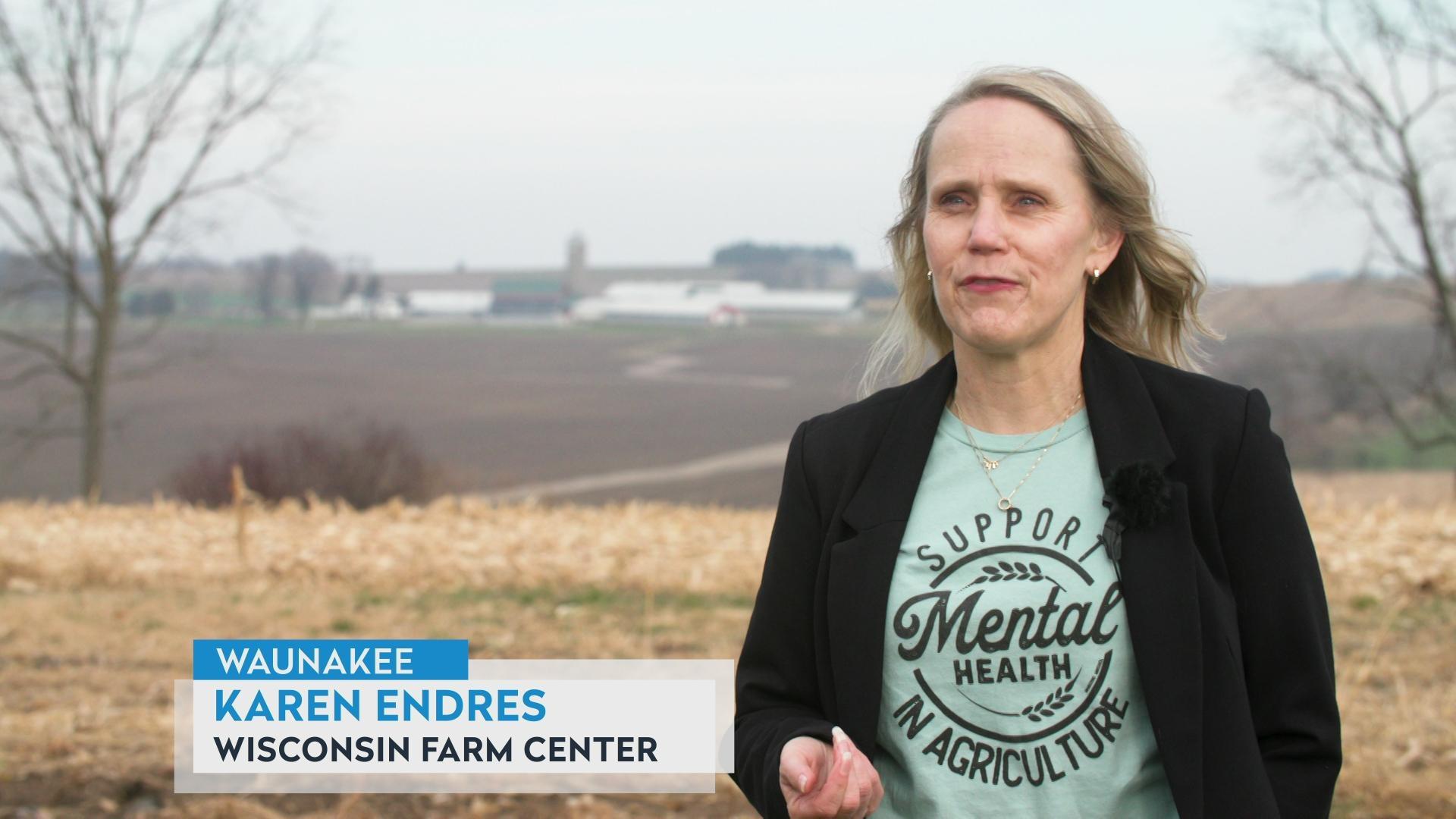

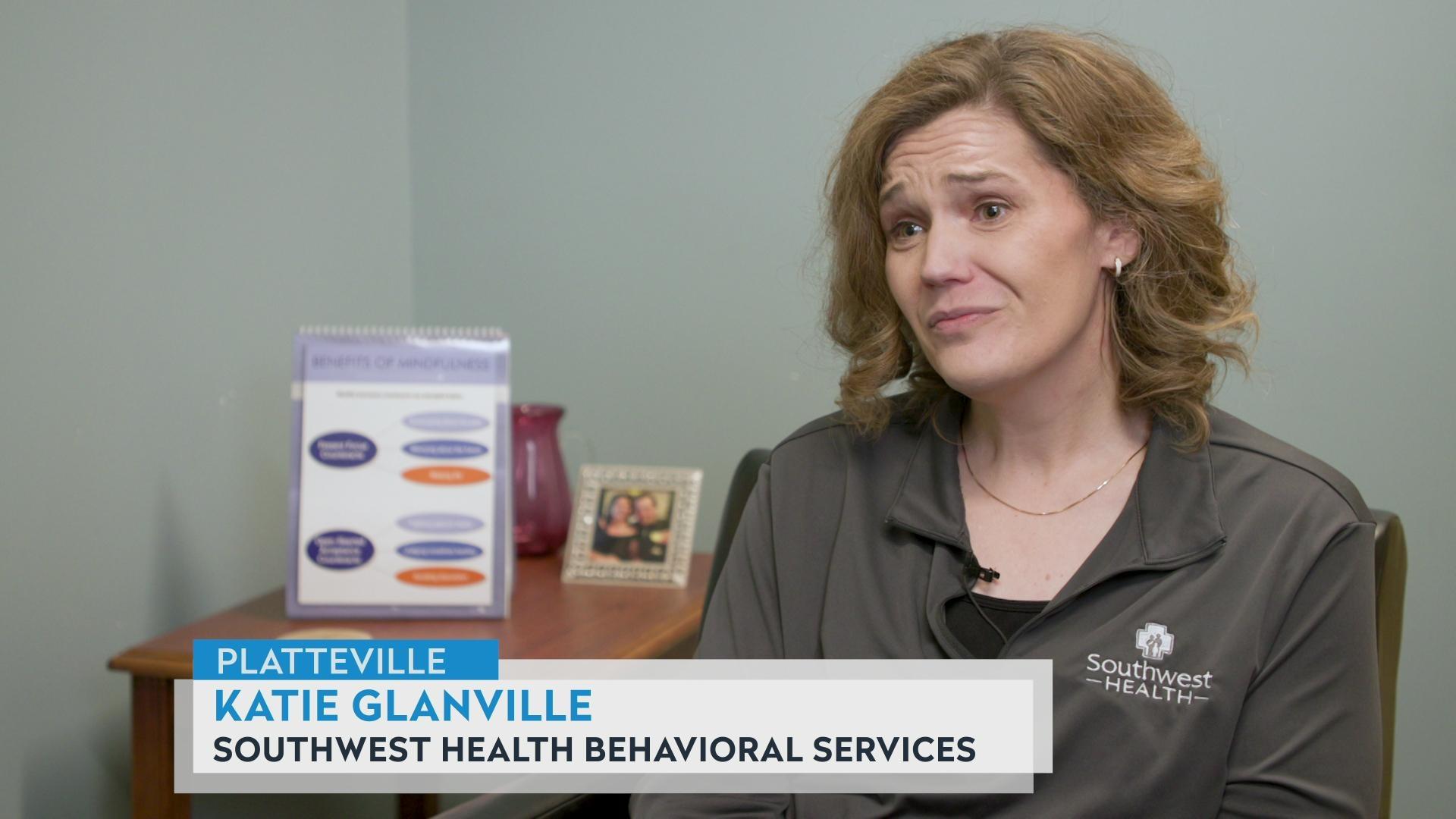



Follow Us